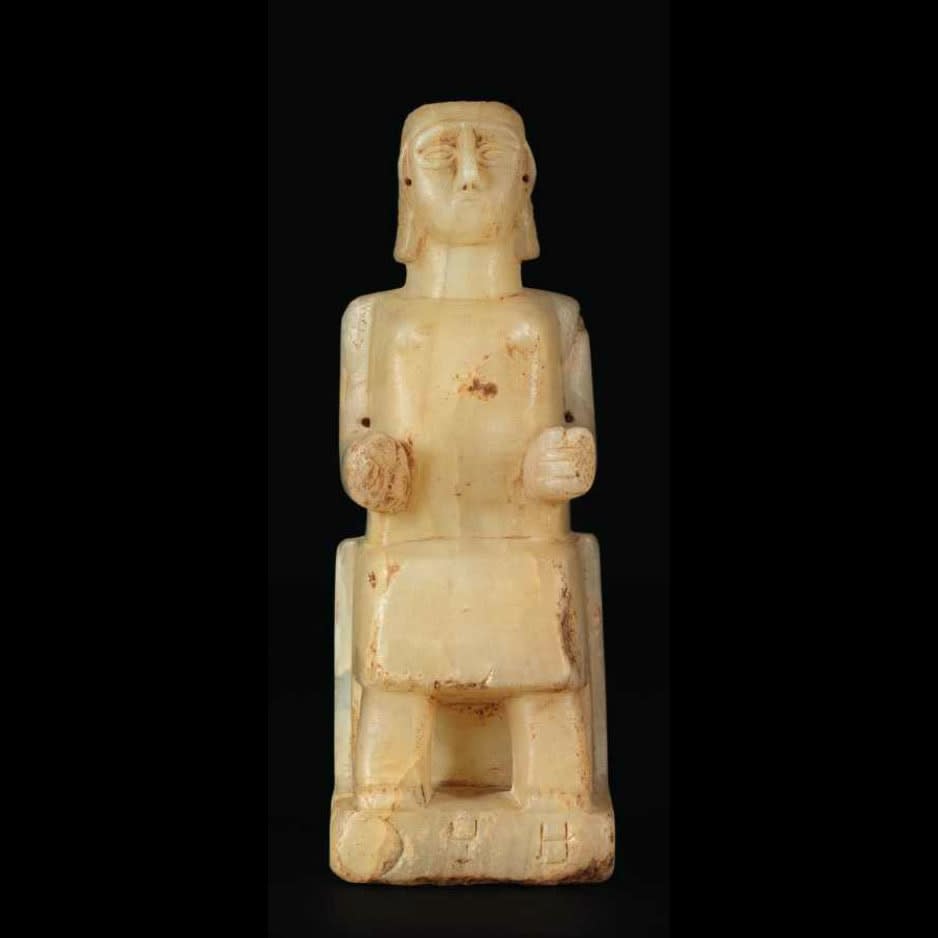Sabaean Seated Statuette of a Woman, 600 BCE - 100 BCE
Calcite-Alabaster
height 20.3 cm
height 8 in
height 8 in
LA.550
The ancient kingdom of Saba ruled over the lands of southern Arabia, centered in modern day Yemen. Saba is perhaps better known as Sheba, the Hebrew word for the kingdom,...
The ancient kingdom of Saba ruled over the lands of southern Arabia, centered in modern day Yemen. Saba is perhaps better known as Sheba, the Hebrew word for the kingdom, whose famous Queen was recounted as having visited Solomon in the pages of the Old Testament. Biblical accounts speak of the wealth of this ancient civilization of traders and merchants, and modern archaeological excavations confirm these reports. Ruins of fortresses and walled towns are evident and remnants of their extensive irrigation system that turned the desert into a paradise still cover the land. Although gold and silver deposits were present, the chief source of their vast wealth was derived from their veritable monopoly of two of the most coveted materials in ancient times: frankincense and myrrh, resinous gums obtained from certain trees that only grow in Southern Arabia and were literally worth their weight in gold. There was not a temple or wealthy house in the ancient world, from Babylon to Rome, where one would not smell the fragrant scents of these incenses. In addition, a trade route that connected India to Egypt that passed through their capital of Marib was another major source of wealth.In the 1st Century A.D., the Ptolemaic Greeks discovered a sea route from India directly to the port of Alexandria, eliminating Saba from her lucrative trade and ushering in the decline of Sabean prosperity.
The female figure is seated wearing a long dress, her hands held before her, the ears and arms pierced,the lower arms projecting horizontally forward at right angles to the upper arms, in a gesture very common in such statuary. A three-letter inscription runs on the front of the base, giving the lady's name: D h r: Dhakir. This name ("proud, noble") is widely attested across the Old-Arabian dialects, both North (Safaitic) and South (Main, Saba, Qataban, Hadramaut). Yet the pose of the figurine would indicate a probably southern provenance, as several early ones have been unearthed from Main, while the use of alabaster was widespread in Qataban.
For comparable examples see: Robin et al, Yemen, au pays de la reine de Saba, Paris, 1997: 156/158-9.
For Old Arabian dialects cfr, Harding G.L., Index and Concordance of Pre-Islamic arabian Names and Inscriptions, Toronto, 1971: p 250.
For a compact study of the name cfr. Sholan, Frauennamen in den Altsudarabischen Inschriften, 1999: p.111.
[Translation and interpretation kindly provided by Prof. Kenneth Kitchen, University of Liverpool]
The female figure is seated wearing a long dress, her hands held before her, the ears and arms pierced,the lower arms projecting horizontally forward at right angles to the upper arms, in a gesture very common in such statuary. A three-letter inscription runs on the front of the base, giving the lady's name: D h r: Dhakir. This name ("proud, noble") is widely attested across the Old-Arabian dialects, both North (Safaitic) and South (Main, Saba, Qataban, Hadramaut). Yet the pose of the figurine would indicate a probably southern provenance, as several early ones have been unearthed from Main, while the use of alabaster was widespread in Qataban.
For comparable examples see: Robin et al, Yemen, au pays de la reine de Saba, Paris, 1997: 156/158-9.
For Old Arabian dialects cfr, Harding G.L., Index and Concordance of Pre-Islamic arabian Names and Inscriptions, Toronto, 1971: p 250.
For a compact study of the name cfr. Sholan, Frauennamen in den Altsudarabischen Inschriften, 1999: p.111.
[Translation and interpretation kindly provided by Prof. Kenneth Kitchen, University of Liverpool]
